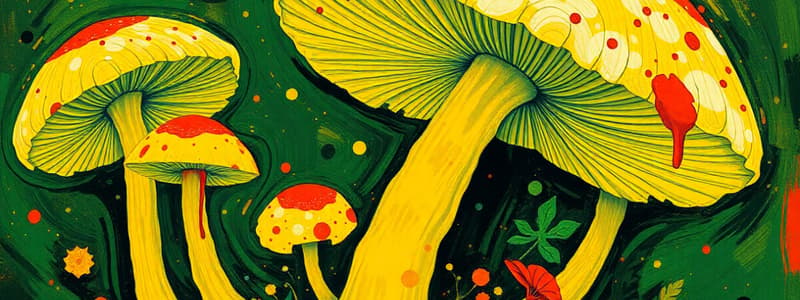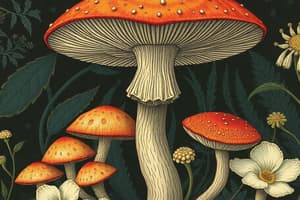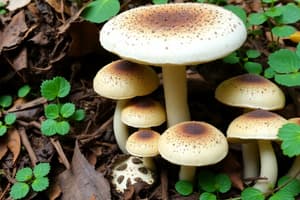Podcast
Questions and Answers
Which complication is specifically associated with gyromitrin poisoning?
Which complication is specifically associated with gyromitrin poisoning?
- Hemolysis (correct)
- Renal failure
- Hepatic failure
- Cerebral edema
What is the primary treatment for severe muscarinic symptoms in mushroom poisoning?
What is the primary treatment for severe muscarinic symptoms in mushroom poisoning?
- Atropine infusion (correct)
- Fomepizole
- Benzodiazepines
- Activated charcoal
In the treatment of renal failure caused by norleucine poisoning, what intervention may be necessary?
In the treatment of renal failure caused by norleucine poisoning, what intervention may be necessary?
- Hemodialysis (correct)
- Gut decontamination
- Mechanical ventilation
- Blood transfusion
What should be administered repeatedly to interrupt enterohepatic circulation of toxins in mushroom poisoning?
What should be administered repeatedly to interrupt enterohepatic circulation of toxins in mushroom poisoning?
Which intervention is suggested for patients at risk of aspiration due to mushroom poisoning?
Which intervention is suggested for patients at risk of aspiration due to mushroom poisoning?
Which complication can arise from amatoxin and gyromitrin poisonings?
Which complication can arise from amatoxin and gyromitrin poisonings?
What initial treatment is recommended for patients experiencing liver and renal toxic syndromes from mushroom poisoning?
What initial treatment is recommended for patients experiencing liver and renal toxic syndromes from mushroom poisoning?
Which medication is indicated for hypoglycemia in mushroom poisoning cases?
Which medication is indicated for hypoglycemia in mushroom poisoning cases?
What is the primary action of gyromitrins in the body?
What is the primary action of gyromitrins in the body?
Which enzyme is affected by gyromitrins that leads to CNS hyperexcitability?
Which enzyme is affected by gyromitrins that leads to CNS hyperexcitability?
What is the main effect of 2-Orellanine in the body?
What is the main effect of 2-Orellanine in the body?
What is the lethal dose of amatoxins?
What is the lethal dose of amatoxins?
What is defined as a poisonous plant?
What is defined as a poisonous plant?
What effect does muscarine have on the autonomic nervous system?
What effect does muscarine have on the autonomic nervous system?
What is the primary cause of mushroom poisoning in humans?
What is the primary cause of mushroom poisoning in humans?
How soon after ingestion of muscarine-containing mushrooms do symptoms typically appear?
How soon after ingestion of muscarine-containing mushrooms do symptoms typically appear?
Which factor does NOT affect the severity of mushroom poisoning?
Which factor does NOT affect the severity of mushroom poisoning?
What complication may result from mushroom poisoning affecting respiratory function?
What complication may result from mushroom poisoning affecting respiratory function?
Which category of mushroom poisoning symptoms appears within the first 6 hours after ingestion?
Which category of mushroom poisoning symptoms appears within the first 6 hours after ingestion?
What is the primary target of alpha-amatoxin in the body?
What is the primary target of alpha-amatoxin in the body?
What is an example of a mushroom toxin?
What is an example of a mushroom toxin?
How many mushroom species are known to cause symptoms in humans when ingested?
How many mushroom species are known to cause symptoms in humans when ingested?
What can potentially alter the toxicity of some mushrooms?
What can potentially alter the toxicity of some mushrooms?
What type of symptoms are categorized as late symptoms of mushroom poisoning?
What type of symptoms are categorized as late symptoms of mushroom poisoning?
Flashcards
Plant Toxicity
Plant Toxicity
Consumption or contact with certain plants in sufficient quantities can cause harm or death to organisms.
Mushroom Poisoning
Mushroom Poisoning
Ingesting toxic mushrooms can cause various symptoms, some potentially lethal.
Mushroom Toxicity Causes
Mushroom Toxicity Causes
Mushroom toxicity stems from toxins within their structures; different mushrooms may have different toxins.
Mushroom Misidentification
Mushroom Misidentification
Signup and view all the flashcards
Mushroom Toxicity Severity
Mushroom Toxicity Severity
Signup and view all the flashcards
Mushroom Toxicity Classification
Mushroom Toxicity Classification
Signup and view all the flashcards
Mushroom Toxins
Mushroom Toxins
Signup and view all the flashcards
Mushroom Processing Effects
Mushroom Processing Effects
Signup and view all the flashcards
Gyromitrin (monomethylhydrazine) effect
Gyromitrin (monomethylhydrazine) effect
Signup and view all the flashcards
2-Orellanine effect
2-Orellanine effect
Signup and view all the flashcards
Muscimol & Ibotenic Acid function
Muscimol & Ibotenic Acid function
Signup and view all the flashcards
Amatoxin toxicity
Amatoxin toxicity
Signup and view all the flashcards
Amatoxin source
Amatoxin source
Signup and view all the flashcards
Muscarine mechanism
Muscarine mechanism
Signup and view all the flashcards
Mushroom poisoning symptoms
Mushroom poisoning symptoms
Signup and view all the flashcards
Mushroom poisoning complication
Mushroom poisoning complication
Signup and view all the flashcards
Mushroom poisoning complications
Mushroom poisoning complications
Signup and view all the flashcards
Neurological complications
Neurological complications
Signup and view all the flashcards
Hepatic complications
Hepatic complications
Signup and view all the flashcards
Renal failure
Renal failure
Signup and view all the flashcards
Hematologic complications
Hematologic complications
Signup and view all the flashcards
Volume resuscitation
Volume resuscitation
Signup and view all the flashcards
Gut decontamination
Gut decontamination
Signup and view all the flashcards
Treatment of agitation
Treatment of agitation
Signup and view all the flashcards
Study Notes
Plant Toxicity
- A poisonous plant is one that, in sufficient amounts, causes harm or death to an organism.
- Examples include mushrooms, foxglove, castor beans, and tobacco.
Mushroom Poisoning
- Mushrooms are the fruiting bodies of fungi.
- Toxicity occurs after ingestion of mushrooms containing toxins.
- Many mushroom species look similar but have vastly different toxicities.
- Approximately 100 species of mushrooms can cause symptoms in humans.
- Only 15-20 species are considered potentially lethal when ingested.
- There's no simple way to distinguish safe from poisonous mushrooms.
Pathophysiology
- Each poisonous mushroom contains one or more toxins.
- Mushroom poisoning severity depends on the mushroom species, location where grown, amount of toxin, and recipient's genetics.
- Cooking, freezing, boiling, or processing does not always eliminate toxicity.
- Poisoning is categorized by the time from ingestion to symptom onset:
- Early: first 6 hours. (gastrointestinal, allergic, or neurological)
- Late: between 6-24 hours. (hepatotoxic, nephrotoxic)
- Delayed: more than 24 hours. (mostly nephrotoxic syndromes)
Mushroom Toxins
- Several toxins exist, including:
- Amatoxins (Cyclopeptides): powerful toxins. 0.1 mg/kg can be lethal. A single mature specimen of Amanita phalloides (death cap) can contain 5-8 mg of amatoxin and is potentially lethal. They are cyclic octapeptides synthesized by Amanita species. Amatoxins are rapidly absorbed from the gastrointestinal tract. They can be detected in urine as early as 90-120 minutes after ingestion. The major toxic action of amatoxins is inhibition of RNA polymerase II, leading to protein synthesis blockage.
- Gyromitrins (monomethylhydrazine): inhibit numerous hepatic systems (including cytochrome P450 and glutathione). Cause hepatic necrosis. Inhibit pyridoxine kinase which is involved in GABA production, leading to CNS hyperexcitability and seizures.
- Orellanine: primarily affects the renal tubules, causing necrosis with relative sparing of the glomeruli.
- Muscimol and ibotenic acid: related to GABA (gamma-aminobutyric acid), acting as GABA receptor agonists. The similar structure allows for mimicking GABA and acting on GABA receptor sites in the nervous system.
- Norleucine: nephrotoxic.
- Muscarine: stimulates M1 & M2 muscarinic receptors. Produces cholinergic symptoms like sweating, facial flushing, salivation, lacrimation, vomiting, abdominal cramps, diarrhea, urination, and miosis.
Complications
- Respiratory: Aspiration pneumonia is a possible complication.
- Neurologic: Convulsions, cerebral edema, hypoxia, acidosis, or trauma.
- Hepatic: Failure and hypoglycemia.
- Renal: Failure, hypoperfusion, and shock.
- Hematologic: Methemoglobinemia, hemolysis,
- Other: Trauma, hypovolemia, electrolyte imbalances.
Treatment
- Early volume resuscitation (fluid rehydration) crucial for liver and renal problems.
- Gut decontamination: Whole bowel irrigation.
- Multiple doses of activated charcoal: Interrupts enterohepatic circulation.
- Endotracheal intubation: Risk of aspiration, needed for hypoxia, acidemia, and shock, mechanical ventilation.
- Agitation: Benzodiazepines.
- Severe muscarinic symptoms: Atropine.
- Disulfiram-containing mushrooms: Fomepizole (blocks alcohol dehydrogenase).
- Severe renal failure: Hemodialysis.
- Severe hyperkalemia or fluid overload: Dialysis
- Blood transfusions: for severe hemolytic anemia, hemorrhagic diarrhea, and blood loss.
- Blood pressure support: Dopamine and norepinephrine if crystalloid and colloid infusions fail
- Hypoglycemia: 10% dextrose infusions.
Studying That Suits You
Use AI to generate personalized quizzes and flashcards to suit your learning preferences.




